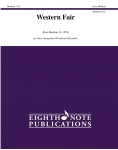PREFACE TO THE SECOND PRINTING 1993
Sinfonia V: Symphonia Sacra et Profana was composed in the Summer of 1973 at Brielle, New Jersey, on commission from the University City High School Wind Ensemble of University City, Missouri; it was premiered by that group in 1974. Subsequently the work was taken up by such distinguished conductors as Eugene Corporon, Thomas Dvorak, Craig Kirchhoff, and H. Robert Reynolds, receiving numerous performances in the United States, Canada and England. Since its publication by Manhattan Beach Music in September of 1989 it has also traveled to Japan and Australia, and has become standard repertoire for high school as well as college bands and wind ensembles.
Sinfonia V is both a musical diary and a musical collage. I incorporated several musics that were much on my mind at the time the work was written, including ragtime, which I had been studying intently for several years, as well as the plainchant hymn, "Divinum Mysterium," which the choir of First Presbyterian Church, Belmar, New Jersey (where I was, and still am, organist and director of music) had used as a processional at Christmas time. If one imagines dialing across the FM radio band in a large city such as New York, the resulting collage (or, to be more accurate, montage, as in film editing) might include a bit of early music (the Pavanne, and the chorales by Samuel Scheidt), some ragtime or jazz, some contemporary music, some voices, some instruments, et cetera.
At the same time, Sinfonia V contrasts secular musics -- such as the Pavanne and the ragtime fragments -- with sacred musics such as the Scheidt chorales and the plainchant hymn. There is no attempt to reconcile these two musical traditions, and the work ends in ambiguity.
Some listeners have found humor in it. I am not so sure. Here are some of the musics I was working with in the Summer of 1973, assembled in what I hope is a convincing musical structure -- no padding, no transitions, no note-spinning. The piece aims to be both concise and kaleidoscopic, profound as well as entertaining, sacred and profane.
Timothy BroegeOceanport, New Jersey
December 24, 1992



